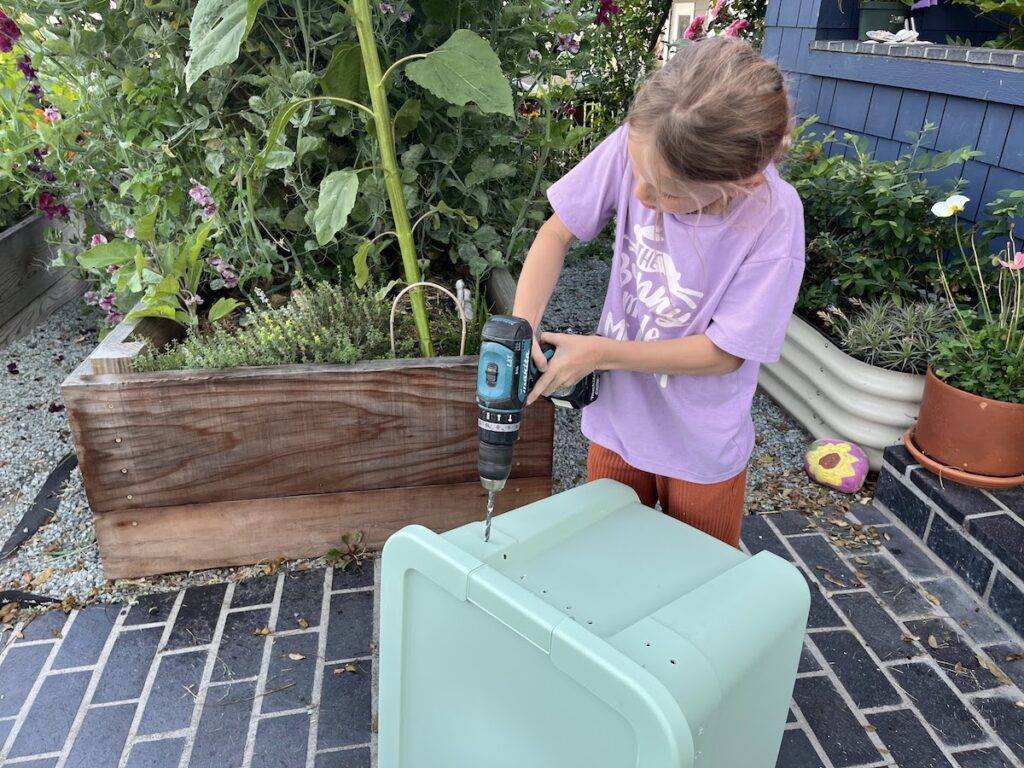Here are eight fun garden activities for you and your children during summer break.
Summer is upon us and while the kids are beyond thrilled, most parents are anxiously trying to figure out what to do with our wild creatures without too much screen-induced sedation. Your garden or local green space can help them connect with nature, stay moving, and keep their brains working. Check out these fun and easy activities, and spend the summer blossoming in nature.
Eight Summer Projects
- Build a worm bin.
Vermicomposting, or a worm bin, is a fun way to compost food scraps and create your own fertilizer. Plus, your kids will be entertained all summer long feeding and playing with their new worm friends as they secretly learn all about worms, their role in soil health, the importance of reducing food waste, and how to care for the little critters. I often find my daughter elbow-deep in the worm bin checking on her friends. Check out this article on vermicomposting and how to create a DIY bin.

- Raise monarchs.
Monarchs are beautiful magical creatures that have captured our hearts in my home. We are obsessed and have made a commitment to their recovery by turning our garden into a monarch waystation. Spend the summer learning about their needs, why they are struggling, and how we can help. Then act! Transform your garden into a waystation by providing their host plant (milkweed), pollinator-friendly plants with tons of nectar, shelter, and sun to support all stages of their lifecycle from egg, caterpillar, and chrysalis to colorful butterfly. Once you establish milkweed and nectar-rich flowers, the monarchs appear like magic. Kids can explore the garden daily to find and monitor the different stages of their lifecycle. When possible, choose native milkweed and pollinator plants; check out the California Native Plant Society for ideas that work best in your area.


- Start a native plant garden filled with fairies.
As more and more gardeners are incorporating native plants and flowers into their gardens, let the magic continue by having your kids build a fairy garden in the midst of your native garden. Native flowers are wild and magical, and they provide the perfect setting for fairies to rest their tired wings. Go on a nature walk and collect sticks, leaves, and stones to build houses, swings, bridges, and anything your child’s imagination can dream up. Nestle this area into a portion of the garden that kids can easily access and let the magic begin.

- Build insect water stations.
Just like us, insects need water, food, and shelter. Find a shallow saucer, like a pot saucer. Fill it with pebbles or glass beads for a pop of color. Fill the saucer with water. The pebbles or glass beads should be partially above the water line so bugs, bees, and butterflies can take a seat when taking a sip and then easily fly away.
- Create nature art.
Explore your garden and neighborhood, and collect sticks, leaves, flowers, seed pods, etc. Encourage kids to collect nature in all stages of the lifecycle, allowing them to see beauty in all it. Now let them create! Using what they found, have them make different pictures and collages. They can choose to glue them on a piece of paper or take pictures of their final creations before adding the items to your compost bins or returning it to the great outdoors.

- Raise rock pets.
Collect rocks in various sizes, and then dig through your craft box for acrylic paint, or use leftover house paint. Have fun learning about mixing colors and creating some new shades with your leftover paint. Now get painting! Have the kids create garden pets, creatures, make handprints, or simply create nature-inspired designs. This is a fun neighborhood activity, so invite friends over and make it a rock-painting party!
- Start a pet veggie garden.
Get the kids invested in the garden, and build environmental activists in the process. Provide space just for them to plant and care for. It doesn’t matter how big. A grow bag or a few pots is a great place to start. Incorporating family pets into the project is a fun way to encourage their commitment to their space. Pick herbs, flowers, and veggies you can share with your furry family members. Check out our article on gardening for your pets for more ideas.
- Give back.
Gather the neighbor kids and organize a neighborhood cleanup. Everyone gets to enjoy fresh air and sunshine, move their bodies, and help take care of their neighborhood. Or notice a neighbor’s yard could use some help with weeding? Offer to help by organizing a group and bring some lemonade. This activity will foster a sense of responsibility and community in your kids this summer!


